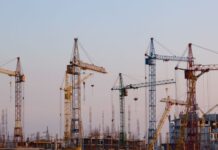Land grading is a crucial process in construction and landscaping that involves shaping the land to achieve optimal drainage and prevent water damage.
In areas like Utah, which experiences varying weather conditions, proper land grading becomes even more critical. Notably, Asphalt paving is a common solution adopted by various construction and landscaping companies in Utah to enhance land grading.


The use of asphalt provides a durable, smooth, and watertight surface, which plays a crucial role in directing water flow during rainy seasons. Properly installed asphalt paving ensures water is effectively drained away from the structures, reducing the risk of water damage.
Thus, in the context of Utah, asphalt paving becomes an essential part of an effective land grading strategy, demonstrating the nexus between these two aspects.
In this blog post, we explore the importance of effective land grading techniques in preventing water-related issues, improving drainage, and creating a safer and more resilient environment.
1. Proper Water Runoff Management
One of the primary goals of effective land grading is to manage water runoff efficiently. Improper slope or grading can lead to water pooling or flooding, causing damage to structures and landscapes. By carefully shaping the land to create slopes that direct water away from buildings and into appropriate drainage systems, effective land grading helps to prevent water accumulation and potential damage.
2. Prevention of Erosion
Erosion is a significant concern when it comes to land management. Poorly graded land can result in soil erosion, which not only affects the stability of the land but also contributes to sedimentation in nearby bodies of water. Effective land grading helps prevent erosion by creating proper contours and slopes that encourage water to flow in controlled pathways, minimizing soil loss and protecting the surrounding environment.
3. Improvement of Surface Drainage
Effective land grading techniques contribute to improved surface drainage by ensuring that water flows away from structures and landscaped areas. By creating gentle slopes and strategically placed swales, land graders can redirect water to designated drainage systems or natural watercourses. This helps prevent water from pooling, reducing the risk of water damage and promoting healthier vegetation growth.
4. Protection of Foundations and Structures
Proper land grading plays a vital role in protecting the foundations and structures of buildings. When land is inadequately graded, water can accumulate around foundations, leading to moisture infiltration and potential damage. Effective land grading helps direct water away from structures, ensuring that foundations remain dry and stable. This not only prevents potential structural issues but also minimizes the risk of mold growth and other water-related problems.
5. Creation of Safer Outdoor Spaces
Effective land grading techniques contribute to the creation of safer outdoor spaces for both residential and commercial properties. By promoting proper drainage, land graders help prevent slippery surfaces and standing water, reducing the risk of accidents such as slips and falls. This is especially important in areas such as walkways, parking lots, and recreational areas where safety is a top priority.
6. Increased Resilience to Extreme Weather Events
Proper land grading enhances the resilience of properties to extreme weather events. When land is carefully graded, it can better withstand heavy rainfall and storms by efficiently channeling water away from vulnerable areas. This reduces the risk of flooding and water damage, making properties more resilient and less prone to costly repairs and disruptions.
7. Enhanced Aesthetics and Landscape Design
In addition to functional benefits, effective land grading also contributes to enhanced aesthetics and landscape design. Proper slopes and contours help create visually appealing landscapes by shaping the land into harmonious and balanced forms. This improves the overall curb appeal of properties and adds value to the surrounding environment.
Effective land grading is a crucial process for preventing water damage, improving drainage, and creating a safer and more resilient environment.
Proper grading techniques ensure proper water runoff management, prevent erosion, protect foundations and structures, create safer outdoor spaces, and increase resilience to extreme weather events.
By investing in effective land grading, property owners can mitigate water-related issues, enhance the functionality and aesthetics of their spaces, and promote a healthier and more sustainable environment.


























